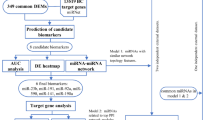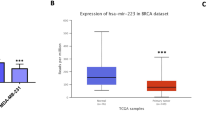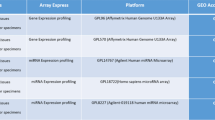Abstract
Background
MicroRNAs and tRFs (tRNA-derived fragments) are small non-coding RNAs that are promising breast cancer (BC) biomarkers. miRNA sequences are found within tRFs. For example, miR-1260a and miR-4521 sequences are found within tRF-3001a and tRF-1003, respectively. No study has addressed the biomarker potential of these tRF-miRNA pairs in BC or their association with other BC miRNA biomarkers.
Methods and results
Real-time PCR was performed to examine the expression of miR-1260a-tRF-3001a and miR-4521-tRF-1003 pairs in plasma of BC patients. miR-4521 and miR-1260a showed no change in plasma of breast cancer patients (n = 19). On the contrary, both the corresponding tRFs (tRF-1003 and tRF-3001a) were down-regulated. Also, we performed miRNA/mRNA network analysis for miR-1260a and miR-4521 with top degree BC biomarkers miR-16-5p and miR-93-5p. We found that they shared nine target genes. Moreover, miR-16-5p was down-regulated, and miR-93-5p was up-regulated in the same sample set. Survival analysis plotted using clinical data from Kaplan–Meier Plotter showed that all four miRNAs and 8/9 target gene expressions could predict the survival of BC patients.
Conclusions
Our cohort analyses suggest that tRF-3001a and tRF-1003 serve as better biomarkers than their miRNA counterparts in addition to miR-93-5p and miR-16-5p. Also, they form a significant miRNA/mRNA biomarker cluster.





Similar content being viewed by others
Abbreviations
- tRFs:
-
tRNA-derived fragments
- BC:
-
Breast cancer
- tiRNA:
-
tRNA-derived stress-induced RNA
- AGO:
-
Argonaute
References
Maattick JS (2001) Non-coding RNAs: the architects of eukaryotic complexity. EMBO Rep 2(11):986–991. https://doi.org/10.1093/embo-reports/kve230
Lee YS, Shibata Y, Malhotra A, Dutta A (2009) A novel class of small RNAs: tRNA-derived fragments (tRFs). Genes Dev 23(22):2639–2649. https://doi.org/10.1101/gad.1837609
Yamasaki S, Ivanov P, Hu GF, Anderson P (2009) Angiogenin cleaves tRNA and promotes stress-induced translational repression. J Cell Biol 185:35–42. https://doi.org/10.1083/jcb.200811106
Pederson T (2010) Regulatory RNAs derived from transfer RNA? RNA 16(10):1865. https://doi.org/10.1261/rna.2266510
Liao JY, Ma LM, Guo YH, Zhang YC, Zhou H, Shao P (2010) Deep sequencing of human nuclear and cytoplasmic small RNAs reveals an unexpectedly complex subcellular distribution of miRNAs and tRNA 3′ trailers. PLoS ONE. 5(5):e10563. https://doi.org/10.1371/journal.pone.0010563
Kumar P, Kuscu C, Dutta A (2016) Biogenesis and function of transfer RNA-related fragments (tRFs). Trends Biochem Sci 41(8):679–689. https://doi.org/10.1016/j.tibs.2016.05
Iorio MV, Ferracin M, Liu CG, Veronese A, Spizzo R, Sabbioni S, Magri E, Pedriali M, Fabbri M, Campiglio M (2005) MicroRNA gene expression deregulation in human breast cancer. Cancer Res 65(16):7065–7070. https://doi.org/10.1158/0008-5472.CAN-05-1783
Filipów S, Łaczmański Ł (2019) Blood circulating miRNAs as cancer biomarkers for diagnosis and surgical treatment response. Front Genet 11(10):169. https://doi.org/10.3389/fgene.2019.00619
Dhahbi JM, Spindler SR, Atamna H, Boffelli D, Martin DI (2014) Deep sequencing of serum small RNAs identifies patterns of 5′ tRNA half and YRNA fragment expression associated with breast cancer. Biomark Cancer 6:BIC.S20764. https://doi.org/10.4137/BIC.S20764
Huang Y, Ge H, Zheng M, Cui Y, Fu Z, Wu X, Xia Y, Chen L, Wang Z, Wang S (2020) Serum tRNA-derived fragments (tRFs) as potential candidates for diagnosis of nontriple negative breast cancer. J Cell Physiol 235(3):673–695. https://doi.org/10.1002/jcp.29185
Kuscu C, Kumar P, Kiran M, Su Z, Malik S, Dutta A (2018) tRNA fragments (tRFs) guide Ago to regulate gene expression post-transcriptionally in a Dicer-independent manner. RNA 24(8):1093–1105. https://doi.org/10.1261/rna.066126.118
Kozomara A, Griffiths-Jones S (2014) miRBase: annotating high confidence microRNAs using deep sequencing data. Nucl Acids Res 42(D1):D68–D73. https://doi.org/10.1093/nar/gkt1181
Pekarsky Y, Balatti V, Palamarchuk A, Rizzotto L, Veneziano D, Nigita G, Rassenti LZ, Pass HI, Kipps TJ, Liu CG, Croce CM (2016) Dysregulation of a family of short noncoding RNAs, tsRNAs, in human cancer. Proc Natl Acad Sci 2:5071–5076. https://doi.org/10.1073/pnas.1604266113
Maute RL, Schneider C, Sumazin P, Holmes A, Califano A, Basso K, Dalla-Favera R (2013) tRNA-derived microRNA modulates proliferation and the DNA damage response and is down-regulated in B cell lymphoma. Proc Natl Acad Sci 110(4):1404–1409. https://doi.org/10.1073/pnas.1206761110
Venkatesh T, Suresh PS, Tsutsumi R (2016) tRFs: miRNAs in disguise. Gene 579(2):133–138. https://doi.org/10.1016/j.gene.2015.12.058
Sugita BM, Pereira SR, de Almeida RC, Gill M, Mahajan A, Duttargi A, Kirolikar S, Fadda P, de Lima RS, Urban CA, Makambi K (2019) Integrated copy number and miRNA expression analysis in triple negative breast cancer of Latin American patients. Oncotarget. 10(58):6184. https://doi.org/10.18632/oncotarget.27250
Nawaz M (2017) Extracellular vesicle-mediated transport of non-coding RNAs between stem cells and cancer cells: implications in tumor progression and therapeutic resistance. Stem Cell Investig 4:83. https://doi.org/10.21037/sci.2017.10.04
Camps C, Saini HK, Mole DR, Choudhry H, Reczko M, Guerra-Assunção JA, Tian YM, Buffa FM, Harris AL, Hatzigeorgiou AG, Enright AJ (2014) Integrated analysis of microRNA and mRNA expression and association with HIF binding reveals the complexity of microRNA expression regulation under hypoxia. Mol Cancer 13(1):1–21. https://doi.org/10.1186/1476-4598-13-28
Razaviyan J, Hadavi R, Tavakoli R, Kamani F, Paknejad M, Mohammadi-Yeganeh S (2018) Expression of miRNAs targeting mTOR and S6K1 genes of mTOR signaling pathway including miR-96, miR-557, and miR-3182 in triple-negative breast cancer. Appl Biochem Biotechnol 186(4):1074–89. https://doi.org/10.1007/s12010-018-2773-8
Sharbati-Tehrani S, Kutz-Lohroff B, Bergbauer R, Scholven J, Einspanier R (2008) miR-Q: a novel quantitative RT-PCR approach for the expression profiling of small RNA molecules such as miRNAs in a complex sample. BMC Mol Biol 9(1):1–3. https://doi.org/10.1186/1471-2199-9-3-4
Licursi V, Conte F, Fiscon G, Paci P (2019) MIENTURNET: an interactive web tool for microRNA-target enrichment and network-based analysis. BMC Bioinform 20(1):1. https://doi.org/10.1186/s12859-019-3105-x
Chang L, Zhou G, Soufan O, Xia J (2020) miRNet 2.0: network-based visual analytics for miRNA functional analysis and systems biology. Nucl Acids Res 48(W1):244–251. https://doi.org/10.1093/nar/gkaa467
Nagy Á, Lánczky A, Menyhárt O, Győrffy B (2018) Validation of miRNA prognostic power in hepatocellular carcinoma using expression data of independent datasets. Sci Rep 8(1):1–9. https://doi.org/10.1038/s41598-018-27521-y
Lánczky A, Nagy Á, Bottai G, Munkácsy G, Szabó A, Santarpia L, Győrffy B (2016) miRpower: a web-tool to validate survival-associated miRNAs utilizing expression data from 2178 breast cancer patients. Breast Cancer Res Treat 160(3):439–446. https://doi.org/10.1007/s10549-016-4013-7
Györffy B, Lanczky A, Eklund AC, Denkert C, Budczies J, Li Q, Szallasi Z (2010) An online survival analysis tool to rapidly assess the effect of 22277 genes on breast cancer prognosis using microarray data of 1809 patients. Breast Cancer Res Treatment 123(3):725–731. https://doi.org/10.1007/s10549-009-0674-9
Martinez-Gutierrez AD, Cantú de León D, Millan-Catala O, Coronel-Hernandez J, Campos-Parra AD, Porras-Reyes F, Exayana-Alderete A, López-Camarillo C, Jacobo-Herrera NJ, Ramos-Payan R, Pérez-Plasencia C (2020) Identification of miRNA master regulators in breast cancer. Cells 9(7):1610. https://doi.org/10.3390/cells907161
Rinnerthaler G, Hackl H, Gampenrieder SP, Hamacher F, Hufnagl C, Hauser-Kronberger C, Zehentmayr F, Fastner G, Sedlmayer F, Mlineritsch B, Greil R (2016) miR-16-5p is a stably-expressed housekeeping microRNA in breast cancer tissues from primary tumors and from metastatic sites. Int J Mol Sci 17(2):156. https://doi.org/10.3390/ijms17020156
Li N, Miao Y, Shan Y, Liu B, Li Y, Zhao L, Jia L (2017) MiR-106b and miR-93 regulate cell progression by suppression of PTEN via PI3K/Akt pathway in breast cancer. Cell Death Dis 8(5):e2796. https://doi.org/10.1038/cddis.2017.119
Vigneron N, Meryet-Figuière M, Guttin A, Issartel JP, Lambert B, Briand M, Louis MH, Vernon M, Lebailly P, Lecluse Y, Joly F (2016) Towards a new standardized method for circulating miRNAs profiling in clinical studies: interest of the exogenous normalization to improve miRNA signature accuracy. Mole Oncol 10(7):981–992. https://doi.org/10.1016/j.molonc.2016.03.005
Keam SP, Hutvagner G (2015) tRNA-derived fragments (tRFs): emerging new roles for an ancient RNA in the regulation of gene expression. Life 5(4):7065–7070. https://doi.org/10.3390/life5041638
Feng X, Yan N, Sun W, Zheng S, Jiang WJ, GuoC HL, Tian LS, Sun MZ (2019) miR-4521-FAM129A axial regulation on ccRCC progression through TIMP1/MMP2/MMP9 and MDM2/p53/Bcl2/Bax pathways. Cell Death Discovery 5(1):1–15. https://doi.org/10.1038/s41420-019-0167-5
Xing S, Tian Z, Zheng W, Yang W, Du N, Gu Y, Yin J, Liu H, Jia X, Huang D, Liu W (2021) Hypoxia downregulated miR-4521 suppresses gastric carcinoma progression through regulation of IGF2 and FOXM1. Mole Cancer 20(1):1–9. https://doi.org/10.1186/s12943-020-01295-2
Ayesha M, Majid A, Zhao D, Greenaway FT, Yan N, Liu Q, Liu S, Sun MZ (2021) MiR-4521 plays a tumor repressive role in growth and metastasis of hepatocarcinoma cells by suppressing phosphorylation of FAK/AKT pathway via targeting FAM129A. J Adv Res. https://doi.org/10.1016/j.jare.2021.05.003
Dai X, Ding L, Liu H, Xu Z, Jiang H, Handelman SK, Bai Y (2019) Identifying interaction clusters for MiRNA and MRNA pairs in TCGA network. Genes 10(9):702. https://doi.org/10.3390/genes10090702
Dwivedi SK, Mustafi SB, Mangala LS, Jiang D, Pradeep S, Rodriguez-Aguayo C, Ling H, Ivan C, Mukherjee P, Calin GA, Lopez-Berestein G, Sood AK, Bhattacharya R (2016) Therapeutic evaluation of microRNA-15a and microRNA-16 in ovarian cancer. Oncotarget 7(12):15093–15104. https://doi.org/10.18632/oncotarget.7618
Guo S, Guo W, Li S, Dai W, Zhang N, Zhao T, Wang H, Ma J, Yi X, Ge R, Wang G (2016) Serum miR-16: a potential biomarker for predicting melanoma prognosis. J Investig Dermatol 136(5):985–993. https://doi.org/10.1016/j.jid.2015.12.041
Kolacinska A, Morawiec J, Pawlowska Z, Szemraj J, Szymanska B, Malachowska B, Morawiec Z, Morawiec-Sztandera A, Pakula L, Kubiak R, Zawlik I (2014) Association of microRNA-93, 190, 200b and receptor status in core biopsies from stage III breast cancer patients. DNA Cell Biol 33(9):624–629. https://doi.org/10.1089/dna.2014.2419
Fabbri E, Montagner G, Bianchi N, Finotti A, Borgatti M, Lampronti I, Cabrini G, Gambari R (2016) Microrna mir-93-5p regulates expression of IL-8 and VEGF in neuroblastoma SK-N-AS cells. Oncol Rep 35(5):2866–2872. https://doi.org/10.3892/or.2016.4676
Ni Q, Stevic I, Pan C, Müller V, Oliveira-Ferrer L, Pantel K, Schwarzenbach H (2018) Different signatures of miR-16, miR-30b and miR-93 in exosomes from breast cancer and DCIS patients. Sci Rep 8(1):1. https://doi.org/10.1038/s41598-018-31108-y
Pan C, Sun G, Sha M, Wang P, Gu Y, Ni Q (2021) Investigation of miR-93-5p and its effect on the radiosensitivity of breast cancer. Cell Cycle. https://doi.org/10.1080/15384101.2021.1930356
Lucá R, Averna M, Zalfa F, Vecchi M, Bianchi F, La Fata G, Del Nonno F, Nardacci R, Bianchi M, Nucifor P, Munck S, Parrella P, Moura R, Signori E, Alston R, Kuchnio A, Farace MG, Fazio VM, Piacentini M, De Strooper B, Bagni C (2013) The fragile X protein binds mRNAs involved in cancer progression and modulates metastasis formation. EMBO Mol Med 5(10):1523–1536. https://doi.org/10.1002/emmm.201302847
Li Y, Huang J, Yang D, Xiang S, Sun J, Li H, Ren G (2018) Expression patterns of E2F transcription factors and their potential prognostic roles in breast cancer. Oncol Lett 15(6):9216–9230. https://doi.org/10.3892/ol.2018.8514
Mullan PB, Bingham V, Haddock P, Irwin GW, Kay E, McQuaid S, Buckley NE (2019) NUP98-a novel predictor of response to anthracycline-based chemotherapy in triple negative breast cancer. BMC Cancer 19(1):236. https://doi.org/10.1186/s12885-0190-5407-9
Takahashi F, Chiba N, Tajima K (2011) Breast tumor progression induced by loss of BTG2 expression is inhibited by targeted therapy with the ErbB/HER inhibitor apatinib 1. Oncogene 30:3084–3095. https://doi.org/10.1038/onc.2011.24
Inoue T, Maeno A, Talbot C (2009) Purine-rich element binding protein (PUR) alpha induces endoplasmic reticulum stress response, and cell differentiation pathways in prostate cancer cells. Prostate 69(8):861–873. https://doi.org/10.1002/jcp.29185
Van Geldermalsen M, Wang Q, Nagarajah R, Marshall AD, Thoeng A, Gao D, Ritchie W, Feng Y, Bailey CG, Deng N (2016) Asct2/slc1a5 controls glutamine uptake and tumour growth in triple-negative basal-like breast cancer. Oncogene 35:3201–3208. https://doi.org/10.1038/onc.2015.381
Lord CC, Thomas G, Brown JM (2013) Mammalian alpha beta hydrolase domain (ABHD) proteins lipid metabolizing enzymes at the interface of cell signaling and energy metabolism. Biochim Biophys Acta 1831(4):792–802. https://doi.org/10.1016/j.bbalip.2013.01.002
Shuba YM (2019) Ca2+ channel-forming ORAI proteins: cancer foes or cancer allies? Exp Oncol 41(3):200–206. https://doi.org/10.32471/exp-oncology.2312-8852.vol-41-no-3.13473
Déry M-A, Jodoin J, Ursini-Siegel J, Aleynikova O, Ferrario C, Hassan S, Basik M, LeBlanc AC (2013) Endoplasmic reticulum stress induces PRNP prion protein gene expression in breast cancer. Breast Cancer Res 15:R22. https://doi.org/10.3390/genes10090702
Acknowledgements
TV acknowledges Grants from Nitte (Deemed to be University) (NURG/STF/06/7-2015), DST-SERB (YSS/2014/000061), and DBT (BT/PR23887/MED/30/1871/2017). PSS thanks faculty seed research grant of National Institute of Technology, Calicut and DBT (BT/PR16307/MED/30/1729/2016). SAH and DKV acknowledge CSIR and DST for the fellowship. Work was initiated at Nitte (Deemed to be University), where TV was working and carried out at the Central University of Kerala. We thank Ms. Farsana M for her technical support.
Author information
Authors and Affiliations
Contributions
TV, PSS designed the project. SAH, DKV, DPN conducted the experiments. VS and NN facilitated the procurement of clinical samples. TV, SAH, DKV, DPN performed data analysis. TV wrote the manuscript with the help of PSS, SAH, VS, and NN.
Corresponding author
Ethics declarations
Conflict of interest
All authors declare that they have no conflict of interest.
Ethical approval
This research followed the tenets of the Declaration of Helsinki. The present study was initiated at Nitte University Centre for Science Education & Research (NUCSER) Mangalore, where TV was working, and further carried out at the Central University of Kerala (CUK) Kasaragod. The research protocol outlining the methodology, study subjects, sample size, data collection, and all related ethical considerations were reviewed. Ethical approval was granted by the Institutional Ethics Committee of NUCSER (February 2016; INST.EC/2015-16/002) and Institutional Human Ethics Committee of CUK (July 2017; CUK/IHEC/2017-002).
Informed consent
All participants have given informed consent before enrolment to the study and have consented to publish the scientific findings of the study.
Research involving animal participants
This article contains no studies conducted with animals.
Additional information
Publisher's Note
Springer Nature remains neutral with regard to jurisdictional claims in published maps and institutional affiliations.
Supplementary Information
Below is the link to the electronic supplementary material.
Rights and permissions
About this article
Cite this article
Hussain, S.A., Deepak, K.V., Nanjappa, D.P. et al. Comparative expression analysis of tRF-3001a and tRF-1003 with corresponding miRNAs (miR-1260a and miR-4521) and their network analysis with breast cancer biomarkers. Mol Biol Rep 48, 7313–7324 (2021). https://doi.org/10.1007/s11033-021-06732-z
Received:
Accepted:
Published:
Issue Date:
DOI: https://doi.org/10.1007/s11033-021-06732-z




